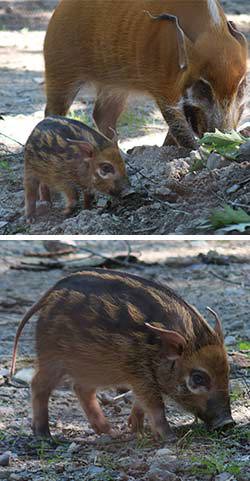A red river hog piglet is hogging the spotlight at Franklin Park Zoo.
Tuesday September 14, 2021
A new little face will have visitors to Franklin Park Zoo squealing with delight. On July 31, red river hog Artemis gave birth to a tiny, watermelon-patterned piglet. Today, the piglet made her exhibit debut, and is expected to be on exhibit when the weather is nice and not raining.

While there were three piglets in the litter, sadly, two did not survive. The remaining piglet, a female, has been doing well and is nursing from mom. She is already starting to investigate some of mom’s food, although she isn’t quite ready to eat solid food yet.
“We’re really thrilled about this birth, which is a first for this species here at Franklin Park Zoo,” says Christine Bartos, Assistant Curator. “Now that the little one has made her exhibit debut, it’s a wonderful opportunity for guests to observe her exploring with mom. Artemis is doing great and being a very attentive mother. This is her first litter, and she has been perfect!”
Zoo New England is a participant in the Red River Hog Species Survival Plan (SSP), a cooperative, inter-zoo program coordinated nationally through the Association of Zoos and Aquariums (AZA). SSPs help to ensure the survival of selected species in zoos and aquariums, most of which are threatened or endangered, and enhance conservation of these species in the wild. This birth was the result of a recommended pairing between the piglet’s parents, Artemis and Tamu.
Red river hogs are native to West and Central Africa, found in thickets, forests, savannas, and swamps. They are social animals and often live in groups (sounders) ranging from two to 15 young females and one adult male. A typical group contains three to six individuals. Grasses, roots, bulbs and fruits are the most common sources of food, although small mammals, reptiles, birds’ eggs and carrion may all be eaten.

